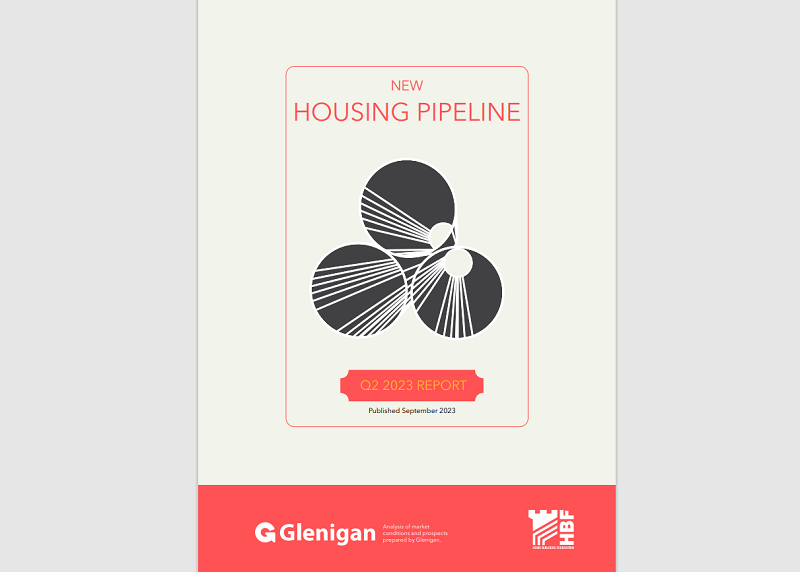The latest HBF Housing Pipeline report based on data supplied by Glenigan, shows the
number of planning permissions being granted across England for new build
houses continued to fall sharply during the second quarter of the year,
continuing the downward trend of the past two years.
Planning permissions are a lead indicator of future
supply levels and the report is the latest data set to confirm industry
warnings that in the midst of an increasingly anti-development policy
environment and worsening economy, the number of homes built in the coming
years could fall to record low levels.
At 2,456, the number of projects granted planning
permission during Q2 of 2023 was the lowest since the Housing Pipeline Report
began recording in 2006. This number is 10% lower than the previous quarter and
20% lower than a year ago. The continued decline follows an 9% decline in Q1
and a 9% decline throughout 2022. This is clear evidence of a far reduced
appetite for investment among house builders amidst a riskier planning
environment, hostile political actions from ministers and wider economic
circumstances.
Approval was granted for 62,681 homes during the second
quarter, dropping 16% on the previous quarter and 13% as compared to the same
period a year ago. Other than the quarter affected by Covid-19, Q2
2020, this is the fewest permissioned homes in a quarter since 2015.

New homes and new sites permissioned during the first
half of 2023 were 19% down on the equivalent period in 2022. If this translates
directly to completions, it will lead to a reduction in housing delivery of
44,000 homes per year which would see Net Housing Supply for England fall to
levels not seen for a decade.
HBF warned earlier this year that if unaddressed, the
Government’s anti-development approach to planning and nutrient neutrality
could see housing supply halve to around 120,000 homes a year. The latest
figures in its Housing Pipeline report prove this scenario to be increasingly
likely.
The Government’s capitulation to the NIMBY wing of the
Conservative party and weakening of the requirements on local authorities to
plan for the homes their communities need has to date seen 60 Local Authorities
pause or withdraw their housing plan preparation; and whilst the Government has
announced proposals to unblock the 150k homes on
hold as a result of the EU Court of Justice ‘Dutch N’ case relating to river
pollution, the moratorium on development still remains in place across 74 local
authority areas.
Meanwhile first-time buyers are struggling to access
the mortgage market, a situation made worse by the fact it is the first time in
decades there is no government support scheme in place for new build first-time
buyers.
Stewart Baseley, Executive Chairman of the Home
Builders Federation says: ““Over recent years the policy environment has become
increasingly anti-development and anti-business and as a direct result we are
seeing a sharp fall in the number of homes being built.
"The Government’s capitulation to the NIMBY lobby
on planning, its mishandling of water legislation and amidst a lack of mortgage
availability the lack of support for first time buyers could see housing supply
drop markedly in the coming years. Fewer homes being built amidst an acute
housing crisis has clear social implications, in particular for young people,
and will reduce economic activity and cost jobs.”
Looking regionally, the sharpest decline was seen in
Yorkshire and the Humber, down 54% on the previous quarter. The East Midlands,
London and the South West followed, with falls of 38%, 25% and 20%
respectively. Four parts of the country bucked the overall downward trend in
approvals during the second quarter. The North East, East of England, West
Midlands and Wales all saw a double digit increase in approvals against the
previous quarter, rising by 26%, 31%, 19% and 26% respectively.
Housing supply
In 2012/13, England saw the lowest peacetime level of
housing supply ever recorded. A series of policies introduced by a Coalition
Government with a desire to build more homes to address decades of undersupply
and boost the economy, led to a rapid increase in output such that by 2019, net
supply in England had doubled, surpassing the highs seen during the housing
booms of the 1950s and 1960s.
The increases in housing supply can be attributed to a
range of factors, including the introduction of the National Planning Policy
Framework (NPPF) in 2012, the Help to Buy Equity Loan Scheme, as well as a
general positive attitude towards development that positioned the UK as an
attractive location for investment in future supply, which allowed homebuilding
to flourish.
However, in the recent period, a hostile political
attitude towards building has driven a policy agenda that has on the whole,
sought to restrict housing delivery.
The proposed changes to the planning system, and the
free rein afforded to Natural England to impose new requirements on development
are risking the progress in tackling the housing crisis made over the past
decade. The combination of these factors has the potential to see net housing
supply drop as low as 111,000 per year, around 10% lower than the previous the
lowest ever annual net supply during peacetime.




















